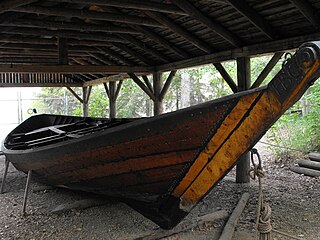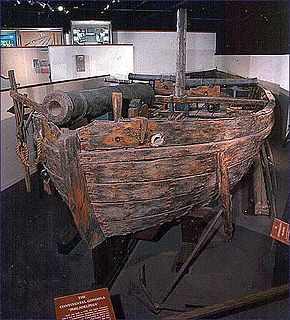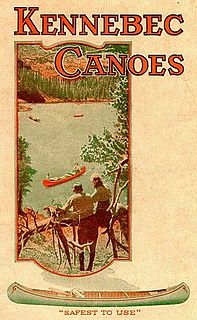History
The Carleton Canoe Company manufactured bateaux and birch bark canoes in the 1870s, operating a mill on the banks of the Penobscot River in Old Town, Maine. They added canvas-covered canoes to their line in the 1880s. At the time, their primary market was lumbermen and guides. [1] Among the early producers of wood-canvas canoes, Carleton appears to be the only one with prior experience building and marketing boats. [2]
In 1906, Carleton built three steel armored bateaux for Commodore Robert E. Peary’s trip to the North Pole. [3]
In 1910, Old Town Canoe purchased the Carleton Canoe Company. [4] When the Carleton factory on South Main Street in Old Town burned on May 17, 1911, all of their canoe building was consolidated with Old Town Canoe. [5]
With the addition of the Carleton line, Old Town created a dual system of distribution that permitted them to have more of their products in the marketplace. [6] Old Town could also vary their products without having to alter their own operation. [7]
During the 1930s, canoe sales became erratic due to the economic depression. Carleton was consolidated under the Old Town name as a cost-saving measure in December of 1934; [8] however, Old Town continued to print Carleton catalogs and sell Carleton canoes into the early 1940s. [9]
Following their acquisition by Old Town in 1910, records of each canoe produced by Carlton were maintained and still exist. Records on serial numbers from approximately 1910 to 1943 have been scanned and can be accessed by providing the number either to Wooden Canoe Heritage Association volunteers online or by contacting the Old Town company. A serial number is located on the upper face of the stem on the floor of the canoe at each end. Build records contain specific information regarding construction of each canoe, including the dates each part of the build-process was accomplished, the date it was shipped and its final destination. [10]

A canoe is a lightweight narrow water vessel, typically pointed at both ends and open on top, propelled by one or more seated or kneeling paddlers facing the direction of travel and using a single-bladed paddle.

Carleton Place is a town in Eastern Ontario, Canada, in Lanark County, about 46 kilometres (29 mi) west of downtown Ottawa. It is located at the crossroads of Highway 15 and Highway 7, halfway between the towns of Perth, Almonte, Smiths Falls, and the nation's capital, Ottawa. Canada's Mississippi River, a tributary of the Ottawa River flows through the town. Mississippi Lake is just upstream by boat, as well as by car.

Thomas John Thomson was a Canadian artist active in the early 20th century. During his short career, he produced roughly 400 oil sketches on small wood panels and approximately 50 larger works on canvas. His works consist almost entirely of landscapes, depicting trees, skies, lakes, and rivers. He used broad brush strokes and a liberal application of paint to capture the beauty and colour of the Ontario landscape. Thomson's accidental death by drowning at 39 shortly before the founding of the Group of Seven is seen as a tragedy for Canadian art.

The Vz. 50 is a Czech made double-action, semi-automatic pistol. Vz is an abbreviation of the Czech term "vzor" meaning model.

The York boat was a type of inland boat used by the Hudson's Bay Company to carry furs and trade goods along inland waterways in Rupert's Land, the watershed stretching from Hudson Bay to the eastern slopes of the Rocky Mountains. It was named after York Factory, the headquarters of the HBC, and modeled after the Orkney yole. Two variations to the York Boat were scows and "Sturgeon Heads."

Tokai Gakki Company, Ltd., often referred to as Tokai Guitars, is a Japanese musical instrument manufacturer situated in Hamamatsu city, Shizuoka prefecture. Tokai is one of Japan's leading companies in the business. The company was founded in 1947 by Tadayouki Adachi and remains family-owned.

Sam the Sudden is a novel by P. G. Wodehouse, first published in the United Kingdom on 15 October 1925 by Methuen, London, and in the United States on 6 November 1925 by George H. Doran, New York, under the title Sam in the Suburbs. The story had previously been serialised under that title in the Saturday Evening Post from 13 June to 18 July 1925.

A sneakbox is a small boat that can be sailed, rowed, poled or sculled. It is predominantly associated with the Barnegat Bay in New Jersey, just as the canoe-like Delaware Ducker is associated with the New Jersey marshes along the Delaware River near Philadelphia.

Julie Olson Williams is a fictional character and member of the Horton family on the NBC daytime drama, Days of Our Lives, a long running serial about working class life in the fictional town of Salem.

USS Philadelphia is a gunboat of the Continental Navy. She was constructed from July-August 1776 for service during the American Revolutionary War. Manned by Continental Army soldiers, she was part of a fleet under the command of General Benedict Arnold that fought against the British Royal Navy in the Battle of Valcour Island on Lake Champlain. Philadelphia was sunk during the battle on 11 October 1776.

Twink is gay slang for a young man in his late teens to early twenties whose traits may include: general physical attractiveness; a slim to average build; and a youthful appearance that may belie an older age.
Locomotives of the London, Tilbury and Southend Railway. Initially, the London, Tilbury and Southend Railway (LTSR) hired Eastern Counties Railway (ECR) locomotives and then after the amalgamation of that railway into the Great Eastern Railway (GER), locomotives from that company were hired. In 1880 the company bought its first locomotive saving on hiring costs from the GER and further engines followed that year. The LTSR principally operated tank engines, which it named after towns on the route. The railway's first locomotive superintendent was Thomas Whitelegg, who in 1910 was succeeded by his son Robert. The LTSR became part of the Midland Railway (MR) in 1912, but nevertheless continued to be operated independently. The Midland removed locomotive names and renumbered engines. The Midland, and its successor the London, Midland and Scottish Railway (LMS), continued to build some designs.

Anton Otto Fischer was an illustrator for the Saturday Evening Post.

Old Town Canoe Company is a historic maker of canoes in Old Town, Maine. The company had its beginnings in 1898, in buildings constructed in 1890 for a shoe business, and was incorporated in 1901. Old Town entered the canoe market as a builder of canvas-covered wooden canoes. In the latter half of the 20th century, the company adopted more modern materials to maintain competitiveness. The company's plant was located along the Penobscot River.

Chestnut Canoe Company was established in Fredericton in the Canadian province of New Brunswick at the end of the 19th century and became one of the pre-eminent producers of wood-and-canvas canoes. The company closed in 1979.
The E.M. White Canoe Company was founded by Edwin White, who produced wood and canvas canoes from 1889 into the 1940s. White is considered one of the pioneers of wood and canvas canoe building and one of several prominent canoe builders in Maine.

The B.N. Morris Canoe Company of Veazie, Maine, produced wood and canvas canoes from 1891 until fire destroyed the factory late in 1919. The shapeliness, style, and workmanship of the Morris canoes and boats made some of the most picturesque craft that were ever built with this construction form.

The Kennebec Boat and Canoe Company was located in Waterville, Maine. Established in 1909 by George F. Terry, the company manufactured wooden canoes and boats until 1941.

E.H. Gerrish (1847-1930) is credited with being the first person to sell wood-canvas canoes commercially. From 1882-1909, Gerrish built and sold canoes from a shop in Bangor, Maine. Early Gerrish canoes contain elements of the birchbark canoes upon which they were based. If studied from earliest-to-latest, the canoes of E.H. Gerrish appear to show the morphing of the wood-canvas from its roots in the birch bark to the modern open gunwale canoe.
"The Old Canoe" was written by Emily Rebecca Page in 1849, appearing in the Portland Transcipt. The poem begins: "Where the rocks are gray and the shore is steep". It was included in school readers and books on elocution, receiving general recognition as a work of merit.


















